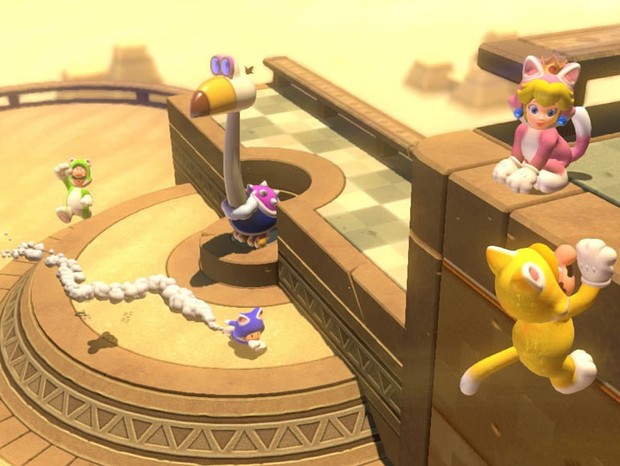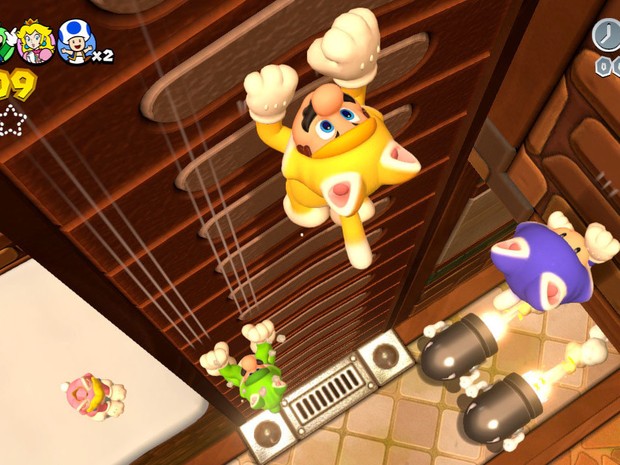I keep running out of time. The flagpole is in sight, little else obstructing my chosen character from its arbitrary, schoolyard height. And yet I dawdle. Something about Super Mario 3D World makes me want to comb every pixel. Even where no secrets hide, I wish to meander, if only to soak it all in. I want to do everything, because so rarely has doing anything been so much like doing nothing at all. This is play as trance-state, the euphoria of oblivion.
Maybe I’m overselling the newest Mario title for Nintendo’s one-year-old Wii U. But it’s hard not to wax ebullient when the landscape into which this title releases is so battle-scarred, gashes rent from the firing of guns and the slashing of sabers. Nintendo has plucked another gem from their storehouse of frivolity. And who better to mainline their trademark joy into our receiving veins than Mario, the dumpy everyman with a ghastly ‘stache who, against all better judgement, has become a mascot for hopeless optimism in our times of uncertainty and decay.

But he’s not alone. For no discernable reason they’ve brought back the ability to choose one of four separate characters, the same from 1988’s Super Mario Bros. 2: not only Mario but Luigi, Princess Peach, and Toad. Many know the story by now: that NES classic, including the different characters and their unique skills, began as a Japanese game called Yume Kojo: Doki Doki Panic. It was brought over to the west as a Mario title when the original sequel was apparently deemed unfun and too hard by Nintendo of America. One game wearing the mask of another: Such transformation embodies what’s best about the latest Mario game twenty-five years later. In a way, Nintendo’s efforts mirror their players’ own, an endless tide of shifting identities, all in search of some ill-defined power.
Super Mario 3D World binges on change. No level repeats itself. In what is ostensibly a treasure hunt swallowed by an obstacle course, you see and do things irreconcilable with those simple tasks. You shoot through clear tubes a mile long. You swing on trapeze ladders. You ride on the back of a water dragon, its weight and physics curiously like a four-person canoe. And throughout the changing landscape, your playable character powers up and morphs into what’s needed at the time. This is standard Mario stuff, but on 3D World’s glistening canvas, nary a speck of unused cloth remains. And in that possibility-explosion we find a familiar fragmenting of abilities.
At any given moment during his travails through the Sprixie Kingdom, Mario will wear a Cat suit, a Raccoon suit, a turtle shell. Upon his head he’ll place a Goomba mask, a coin-block, a cannon, a propeller. He’ll sit inside a giant ice skate. He’ll grow big and he’ll shrink down. We, the player on the couch pushing this action figure around a make-believe landscape, are not like this Mario. Rather, Mario is a lot like us: putting on masks and seeing what works; and in doing so learning how to move on and where to go next.
I’m an instructor at [undisclosed New England college]. Before entering my classroom, I put on my Teacher suit and transform. For awhile this looked like a button-down shirt, tie and a beard. I was still too young and these enemies needed to fear me, or at least sense some kind of unearned power over them. A necktie and facial hair was all I had, so behind them I hid. But the scene preempted the power-up: Back home the tie felt extraneous, a piece of fabric unceremoniously dipped in cereal milk. Now my Teacher suit has changed, become more organic, the needed armor built up from an accumulation of years: a patch of visible scalp, my face and its creased lines.

The mustachioed one and I aren’t all that different, then. Mario walks up to a high wall, scalable only with claws. Punch that question block and behold, a ringing bell. With it transform from pudgy plumber to wily cat, the better to climb tall heights and lash out at lumbering obstacles with the evolved instincts of a hunter. Without this outfit no such skills can be used.
We function through active pretending. We try on a persona in a crowd of new people. We shift between roles in different social settings. We’re capable of feats beyond our ordinary talents. We all strive to be Super. But most of the time, we shrink back down to our normal, humble selves, tiptoeing around that which can hurt us so as not to die.
What Nintendo and their EAD Tokyo #2 studio are able to do is make this kind of existential ambition a great deal of fun. The kind of fun accompanied by audible hoots in an empty room. The kind given simple, profound names like “satisfaction” and “happiness.”
Glance at my screen now and spy a few moments of glee. I don the Cat Suit and leap up a conifer, performing a handstand on the top-most branch and exposing a furry white under belly. Later, with a haunted house’s lights out, moonlight casts Bowser’s shadow on the wall, frightening a poor Toad. Explore further and find a giant cardboard cut-out of the King Koopa, the cause of the scary silhouette. Shatter it and save the Toad from its own cowardice.
Other prodding delivers unexpected rewards. Though most of the game is played through traditional stick-and-button maneuvers, the Wii U GamePad’s touchscreen provides a subtle tangibility. The same image on your television is displayed on the touchscreen; drop a finger on the world at any point and a white gloved hand enters the picture, like some disembodied deity from above having a laugh. Rub suspicious areas and a shimmery translucence may appear: a hidden coin block, perhaps, or an invisible door.

Your glove cursor even interacts directly with the landscape. Run it through sand to paint a line. Tracing it across water causes ripples and splashing. My favorite: Hold the gloved finger on grass and leave it there. Soon, blossoms burst from beneath the dirt. Traverse the ground with your omniscient hand and watch as flowers sprout like colored cursive. This is the ink in which hagiography is written.
The team responsible for Super Mario 3D World, led by Kenta Motokura, should be studied in a lab, if only to learn more about catalyzing that abstract concept of “joy.” Imagine! Pharmaceutical companies developing and selling drugs to combat depression could reallocate their energies elsewhere. Let them cure the physical breakdown of our bodies instead of our minds. Then one day we might live forever, if only due to those first insights gleaned from the brains of Mario’s makers…
If immortality rests beyond our reach, at least we can play this game and be happy, and by doing so rub up against a smidgen of the eternal. There’s a reason ancient Egyptians were buried with their remains watched over by a cat. They lie around, content. They know what they are. For those of us less certain: Power-Up.
